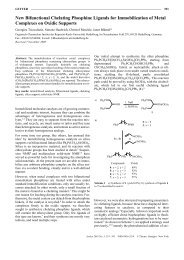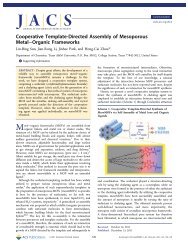CARBONIC ANHYDRASE: why Zinc?
CARBONIC ANHYDRASE: why Zinc?
CARBONIC ANHYDRASE: why Zinc?
You also want an ePaper? Increase the reach of your titles
YUMPU automatically turns print PDFs into web optimized ePapers that Google loves.
<strong>CARBONIC</strong><br />
<strong>ANHYDRASE</strong>:<br />
Why <strong>Zinc</strong>?<br />
By: Amir Safi
What Reaction is<br />
H 2O + CO 2<br />
Catalyzed?<br />
H + + HCO 3 ‐<br />
• Carbonic Anhydrase Catalyzes the Reaction of water + carbon dioxide to form bicarbonate.
CO 2 + H 2 O = HCO 3 - + H +<br />
k uncat = 10 -11 s -1<br />
k cat = 10 4 s -1<br />
Rate of Catalysis
Role of Zn(II) in Proteins<br />
1. Catalytic: involved directly in catalytic steps<br />
(e.g., CA)<br />
2. Structural: required for the stability of a protein structure, or<br />
arrangement of an active site<br />
(e.g., CuZnSOD)<br />
3. Regulatory: Zn-free enzyme has activity, addition of Zn 2+<br />
enhance or inhibit activity<br />
(e.g., zinc finger family of proteins)
<strong>Zinc</strong> Fingers<br />
Cys 2His 2 zinc fingers are found in 2% of all human genes<br />
Jamieson, Andrew C.; Miller, Jeffrey C.; Pabo, Carl O. Nature Rev. Drug Discovery (2003), 2, 361-368.
Hydrolytic reactions
Hydrolytic reactions
Background on Carbonic<br />
Anhydrase<br />
• Carbonic Anhydrase is an enzyme that is<br />
located in red blood cells.<br />
• It contains about .31 to .34% zinc.<br />
• This is important because it’s the first known<br />
direct physiological function of zinc.<br />
http://www.pdb.org/pdb/static.do?p=education_discussion/molecule_of_the_month/pdb49_1.<br />
html
Carbon Anhydrase Mechanism
Step 1: deprotonation<br />
1. Berg, Jeremy M. (2007). Biochemistry, 6th Ed.
Step 2: Carboxylation<br />
• The anionic oxygen then<br />
performs a nucleophilic<br />
attack on the carbon.
Step 3: Formation of Ring Structure<br />
Anionic oxygen forms a bond with Zn 2+ to make a ring‐like<br />
resonance.
Step 4: Formation of Bicarbonate<br />
• Addition of water<br />
displaces the<br />
bicarbonate ion.
Carbonic Anhydrase Mechanism
BIG QUESTION:<br />
WHY DOES CARBON <strong>ANHYDRASE</strong> USE<br />
ZINC?
History of <strong>Zinc</strong><br />
• <strong>Zinc</strong> compounds have been used for at least<br />
2,500 years<br />
• <strong>Zinc</strong> derived its name, supposedly, from the<br />
German word Zinke, which means 'tooth‐like'<br />
or 'pointed'.<br />
• Metallic zinc was first produced in India<br />
sometime in the 1400’s by heating the mineral<br />
calamine (ZnCO 3) with wool.<br />
• <strong>Zinc</strong> was rediscovered by Andreas Sigismund<br />
Marggraf in 1746 by heating calamine with<br />
charcoal.<br />
http://www.buzzle.com/articles/history‐of‐zinc.html
Fe, Zn, Cu: the most common<br />
transition metal ions in biology<br />
ELEMENT Sea Water (M) x 10^‐8 Human Body (M) x 10^‐<br />
8<br />
Fe .005‐2 2230<br />
Zn 8 1720<br />
Cu 1 1650
Properties of <strong>Zinc</strong><br />
• 2+ is the only accessible oxidation state (d 10 )<br />
• Binds both hard and soft donors<br />
• Tetrahedral geometry preferred<br />
• 5‐6 CN are accessible<br />
• Good Lewis acid because high charge/radius<br />
ratio
<strong>Zinc</strong> is d 10<br />
• <strong>Zinc</strong> Ion is<br />
colorless<br />
• Not Redox Active
Hard/ Soft Acid Base Theory<br />
• Good Lewis<br />
acid because<br />
high<br />
charge/radius<br />
ratio
Metals:<br />
Fe 2+ , Ni 2+ , Zn 2+, Co 2+ , Cu 2+<br />
Ligands:<br />
SRˉ, his, Xˉ, RCO 2ˉ<br />
Borderline
<strong>Zinc</strong> Geometry and d orbital Splitting<br />
diagrams.
Why <strong>Zinc</strong>:<br />
RECAP<br />
1. 2+ is the only accessible oxidation state (d 10 )<br />
– No complications from redox activity.<br />
2. Binds both hard and soft donors<br />
3. Tetrahedral geometry preferred/ 5‐6 CN are<br />
accessible
Medical Application:<br />
Treat Glaucoma<br />
Carbonic anhydrase<br />
inhibitors are applicable<br />
during emergencies<br />
because they are able to<br />
rapidly reduce the<br />
pressure that has built up<br />
inside the eye by 40% to<br />
60%. The less fluid that is<br />
allowed to build up yields<br />
less pressure behind the<br />
eye.<br />
http://www.pdb.org/pdb/static.do?p=education_discussion/molecule_of_the_month/pdb49_2.<br />
html
Acetazolamide<br />
Diuretic: Diuretics are drugs that increase the rate of urine flow.<br />
Sold as the drug Diamox<br />
http://jpet.aspetjournals.org/content/115/3/251.abstract
Carbonic Anhydrase Inhibition
Bad News or Good News<br />
Glaucoma:<br />
• The mechanism of action to<br />
lower pressure is not<br />
known. The route of<br />
administration can be oral,<br />
intravenous, topical, or<br />
inhaled by smoking, and it<br />
dictates many of the<br />
behavioral and physiologic<br />
consequences. Of these<br />
routes, smoking has the<br />
more rapid onset of<br />
psychoactive and other<br />
pharmacologic effect
Is <strong>Zinc</strong> Boring?<br />
http://www.youtube.com/watch?v=99wPiMb‐k0o



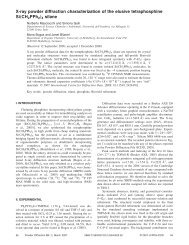
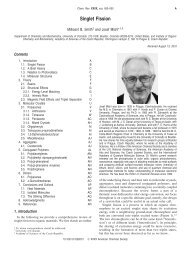
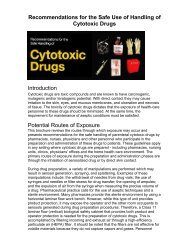
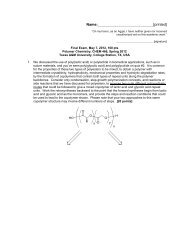
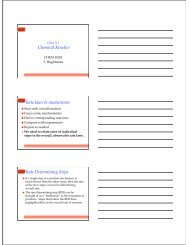
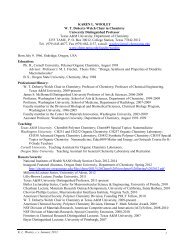
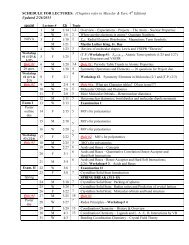
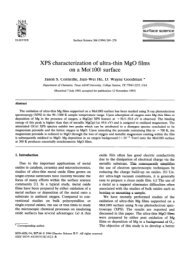
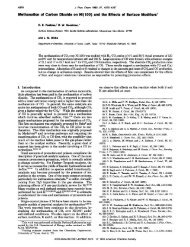
![Radical salts of TTF derivatives with the metal–metal bonded [Re2Cl8]](https://img.yumpu.com/10115211/1/190x253/radical-salts-of-ttf-derivatives-with-the-metal-metal-bonded-re2cl8.jpg?quality=85)



